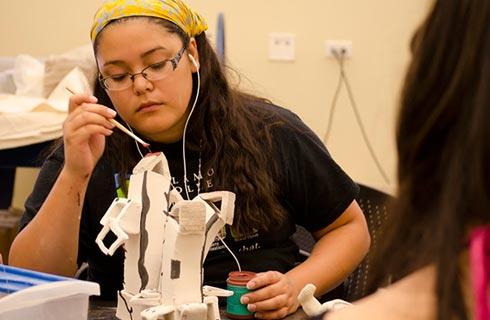艺术史文学硕士-一般艺术史
Master of Arts in Art History - General Art History

学历文凭
Masters Degree

专业院系
Department of Art and Design

开学时间

课程时长

课程学费

国际学生入学条件
For Fall semester admission with assistantship, completed materials must be received at the University by February 15. Applications received after April 1 cannot be guaranteed consideration for the Fall semester. For Spring semester admission, the deadline is November 1.
For the concentration in General Art History, an undergraduate course in each of the major areas of art history is desirable: American, ancient, medieval, renaissance, baroque, and modern. If, after evaluation of the student’s transcript, the art history faculty perceives a deficiency in these areas, the student may be required to successfully complete courses that will not count toward the Master of Arts degree.
A letter of intent, explaining the applicant’s motivation and objectives in pursuing a graduate degree in art history.
A sample of undergraduate writing, preferably in art history.
Two letters of recommendation, at least one of which should be from a college faculty member who knows the student well.
Admission to the Graduate School is open to anyone holding a bachelor’s, master’s, or doctoral degree from an accredited college or university. In cases, where a program’s accrediting body allows alternate admissions standards, exceptions may be made. Applicants should have completed undergraduate or graduate work of sufficient quality and scope to enable them to successfully pursue graduate study. The University of Memphis offers equal educational opportunity to all persons without regard to race, religion, sex, creed, color, national origin or disability.
Baccalaureate Degree: The applicant must provide an official transcript showing that a bachelor’s degree was awarded by an accredited college or university. If you are a UofM undergraduate student applying to Graduate School at UofM, you do not need to request that an official transcript be sent to Graduate Admissions. This office has access to your transcript. In addition, transcripts from any other college or university attended may be requested. Only transcripts received directly from an issuing institution are considered official. Personal copies are not acceptable as official documents.
GPA: The applicant must have earned an acceptable grade point average, typically a minimum of 2.5 on a scale of 4.0, but departments may make exceptions for students whose overall GPA does not adequately reflect their ability to succeed in their chosen field.
English proficiency test scores required by the University:
Duolingo English Test- For students affected by test center closures due to COVID-19, the University is temporarily accepting Duolingo as an alternative. 100 or higher on the overall score, all sub scores must be at least 80.
TOEFL (Test of English as a Foreign Language) Institution code 1459. TOEFL - 550 or higher on the paper version, 79 or higher on the internet-based test
IELTS (International English Language Testing System- 6.0 or higher
PTE (Pearson Test of English) - 53 or higher
IDP—雅思考试联合主办方

雅思考试总分
6.0
- 雅思总分:6
- 托福网考总分:79
- 托福笔试总分:550
- 其他语言考试:PTE (Pearson Test of English) - 53 or higher
CRICOS代码:
申请截止日期: 请与IDP联系 以获取详细信息。
课程简介
孟菲斯大学的艺术史是对艺术的研究,既反映了文化又是塑造文化的积极因素。这样,绘画,雕塑,建筑,摄影,视频,表演,混合媒体以及其他媒体,被理解为与包括文学,哲学,宗教,政治和科学在内的更广泛的文化环境有着复杂的联系。训练学生从跨学科的角度密切分析艺术和视觉文化,同时考虑到创作过程,观众的接受程度和艺术功能。硕士课程的目的是为学生提供在特定艺术和视觉文化领域的专业知识,并为毕业生提供进行进一步的博士研究或一系列就业机会所需的分析培训,写作技巧和研究技术。教育,博物馆和美术馆,自然保护,艺术组织或出版。拥有东南
In the general art history concentration, students focus on developing a comprehensive understanding of art across different time periods, cultures, and artistic movements. The curriculum is designed to provide a broad and in-depth education in art history, covering various art forms, styles, and contexts. Throughout the program, students study the evolution of art from antiquity to contemporary times, exploring the contributions of different artists, art movements, and cultural influences.<br><br>Courses delve into the analysis of iconic artworks, architectural marvels, and significant historical artifacts, enabling students to develop critical thinking skills and visual analysis abilities. They learn to interpret and contextualize art within its historical, social, and political settings, appreciating how artistic expressions reflect broader cultural trends and human experiences.<br><br>The program fosters interdisciplinary approaches, encouraging students to draw connections between art history and other academic disciplines, such as anthropology, sociology, philosophy, or literature. By exploring these connections, students gain a deeper appreciation for the multifaceted aspects of art and its broader impact on society.<br><br>A research-based approach equips students with the skills to critically analyze primary and secondary sources, construct compelling arguments, and present their findings in a coherent and well-structured manner.
In the general art history concentration, students focus on developing a comprehensive understanding of art across different time periods, cultures, and artistic movements. The curriculum is designed to provide a broad and in-depth education in art history, covering various art forms, styles, and contexts. Throughout the program, students study the evolution of art from antiquity to contemporary times, exploring the contributions of different artists, art movements, and cultural influences.<br><br>Courses delve into the analysis of iconic artworks, architectural marvels, and significant historical artifacts, enabling students to develop critical thinking skills and visual analysis abilities. They learn to interpret and contextualize art within its historical, social, and political settings, appreciating how artistic expressions reflect broader cultural trends and human experiences.<br><br>The program fosters interdisciplinary approaches, encouraging students to draw connections between art history and other academic disciplines, such as anthropology, sociology, philosophy, or literature. By exploring these connections, students gain a deeper appreciation for the multifaceted aspects of art and its broader impact on society.<br><br>A research-based approach equips students with the skills to critically analyze primary and secondary sources, construct compelling arguments, and present their findings in a coherent and well-structured manner.
相关申请
 预科
预科 奖学金
奖学金 实习机会
实习机会 在校学习
在校学习 跨境学习
跨境学习 校园授课-线上开始
校园授课-线上开始 在线/远程学习
在线/远程学习
开学时间&学费
学费信息仅供参考,请与IDP联系以获取详细信息
| 开学时间 | 时长 | 学费 | 地点 |
|---|









 美国
美国






